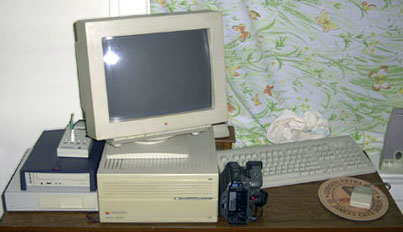In my previous article, I
detailed the ways I have used my hot rodded IIci for audio/video work, and the
response from readers has been wonderful. I have received many
responses that have been both informative and friendly. Thank you to
everyone who wrote about their experiences with multimedia work on
vintage Macs. I hope to continue to provide useful ideas for all of you
that use vintage Macs for this purpose.
My interest in vintage Macs springs from my interest in audio
production and music in general. The Macintosh has been used for this
type of work more often than any other widely available platform. While
the Macintosh was the choice of audio/video professionals for many
years, PCs didn't gain widespread acceptance for serious production
work until more recently.
These days, vintage Macs that are capable of multimedia work are
going for peanuts. Like many Low End Mac
readers, I have quite a few vintage Macs that I have saved from various
fates, and frequently use
eBay to gather the bits and pieces to make them useful again. Each
project has given me new insights into why Mac users are so loyal to
their machines.
However, I have found it difficult to find uses for all of my Macs
and justify the space in my apartment that they occupy. I also have a
home studio that occupies a lot of space, so I decided to try and find
a niche for every Mac I own and allow them to perform a function within
my home studio setup.
As an owner of both vintage 68k Macs and older Power Macs, I needed
to find functions for each Mac and software for the tasks I deemed them
capable of.

The IIci is better suited for video work because of it's superior
Spigot II Tape capture card. It captures at full 30 frames per second
and has been upgraded recently with an external SCSI A/V drive.
I chose my Radius 81/110 for audio
work because newer versions of Digidesign Pro Tools are Power Mac
only, and it contains a Digidesign Audiomedia II card that is far
superior to the PAS 16 in the IIci.
These machines could be networked via AppleTalk, so I could move
files around at my discretion, although it is just as easy to move
external hard drives to different machines.
To physically link all of their audio inputs and outputs, I use
standard 1/4" patchbays
with cable adapters as needed. This gives me the flexibility to patch
any signal in or out of any of my Macs or analog equipment in my
studio. They also make patchbays that are video specific, but my video
signals are on mixed connectors, so I am limited to using the IIci and
patching directly between it and video equipment.
Sometimes I use a combination of two machines for audio work. This
is the case when I use something like Virtual Drummer to create a wacky
low-fi drum beat. I patch the outputs of the IIci's PAS 16 into the
Radius audio inputs on the patchbay and record the beat. I can then
edit and use it within my multitrack recording software.
Because both are already wired into the patchbay, it is a simple
patch from one point to the other on the patchbay. A patchbay
can really help you stay organized when working with multiple audio
sources and saves a lot of time you would spend connecting and
reconnecting your equipment.
For other multimedia studio related tasks, I have a few more Macs
involved. I have been using a Power
Computing PowerBase 180 for organizational duties. I keep the
schedule of studio related work on it and inventory tape stock and
other items. It is also used for Internet access in the studio
area.
I also have a Classic
II that stores names and addresses that are related to studio work
or music. In addition, it sits next to the telephone and looks
cute.
A Few Words about the Radius 81/110
The Radius 81/110 is the newest acquisition in my vintage Macintosh
A/V arsenal. A quick rundown of it's features is probably in order
here, because it performs the bulk of my computer audio functions.
- 82 MB RAM
- 2 GB system drive
- 4 GB A/V drive(controlled by Jackhammer)
- RasterOps Paintboard Prism video card
- FWB Jackhammer SCSI card
- Digidesign Audiomedia II card
- Opcode Translator Pro 2 In 6 Out MIDI interface
I can't say enough good things about this Mac clone. It is a
seriously overbuilt machine meant for A/V work. The power supply is
huge, and the case seems pretty indestructible. It has completed
replaced a much newer Pentium III PC and the IIci for all my audio
production work. I am running a lot of intense audio applications on
it, and it never seems to freeze or cause audio glitches the way my PC
did.
The Digidesign Audiomedia II card has excellent sound quality for
audio mastering work or additional tracks for a project. The best part
is that the entire system cost me less than buying a comparable sound
card for a PC or newer PCI Power Mac.
It's important to be creative when thinking of the ways your vintage
Macs can perform multimedia functions. I have a friend who uses an
LC just for the QuickTime 2.5
instruments and its speech synthesizer. You may find that one Mac makes
a great MIDI sequencer, while another is perfect for CD quality audio
use.
I have found so many uses for my vintage Macs that I may yet find
peace of mind when buying more of them. Use your best judgment, and
don't be afraid to experiment and push the limits of your vintage Macs.
Finding uses for them justifies their continued existence in your home
and makes a good argument for adding more to the collection.
Share your perspective on the Mac by emailing with "My Turn" as your subject.



